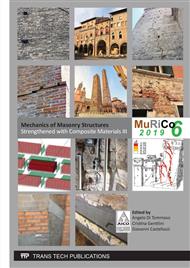[1]
H. Houben, H. Guillaud, Earth construction: a comprehensive guide. London, Intermediate Technology Publication, (2008).
Google Scholar
[2]
R.A. Silva, D.V. Oliveira, T. Miranda, N. Cristelo, M.C. Escobar, E. Soares, Rammed earth construction with granitic residual soils: The case study of northern Portugal, Construction and Building Materials, 47 (2013) 181-191.
DOI: 10.1016/j.conbuildmat.2013.05.047
Google Scholar
[3]
R.A. Silva, N. Mendes, D.V. Oliveira, A. Romanazzi, O. Domínguez-Martínez, T. Miranda, Evaluating the seismic behaviour of rammed earth buildings from Portugal: from simple tools to advanced approaches. Engineering Structures, 157 (2018) 144-156.
DOI: 10.1016/j.engstruct.2017.12.021
Google Scholar
[4]
M. Correia, Rammed earth in Alentejo. Lisbon, Argumentum, (2007).
Google Scholar
[5]
T.T. Bui, Q.B. Bui, A. Limam, S. Maximilien, Failure of rammed earth walls: From observations to quantifications. Construction and Building Materials, 51 (2014) 295-302.
DOI: 10.1016/j.conbuildmat.2013.10.053
Google Scholar
[6]
K. Liu, M. Wang, Y. Wang, Seismic retrofitting of rural rammed earth buildings using eternally bonded fibers. Construction and Building Materials, 100 (2015) 91-101.
DOI: 10.1016/j.conbuildmat.2015.09.048
Google Scholar
[7]
A.A. Costa, H. Varum, H. Rodrigues, G. Vasconcelos, Seismic behaviour analysis and retrofitting of a row building. In Correia M., Lourenço P.B., Varum H., Seismic Retrofitting: Learning from vernacular architecture. London, Taylor and Francis Group, (2015).
DOI: 10.1201/b18856-39
Google Scholar
[8]
G. De Felice, S. De Santis, L. Garmendia, B. Ghiassi, P. Larringa, P.B. Lourenço, D.V. Oliveira, F. Paolacci, C.G. Papanicolaou, Mortar-based systems for externally bonded strengthening of masonry. Materials and Structures, 47 (2014) 2021-2037.
DOI: 10.1617/s11527-014-0360-1
Google Scholar
[9]
B. Ghiassi, G. Marcari, D.V. Oliveira, P.B. Lourenço, Numerical analysis of bond behavior between masonry bricks and composite materials. Engineering Structures, 43 (2012) 210- 220.
DOI: 10.1016/j.engstruct.2012.05.022
Google Scholar
[10]
L. Righetti, V. Edmondson, M. Corradi, A. Borri, Fiberglass grids as sustainable reinforcement of historic masonry. Materials, 9 (2016) 1-17.
DOI: 10.3390/ma9070603
Google Scholar
[11]
J. Vargas, M. Blondet, F. Ginocchio, G. García, 35 Años de investigaciones en sismo adobe: la tierra armada, International Conference SismoAdobe 2005: architecture, construction and conservation of earthen buildings in seismic areas, Lima, (2005).
Google Scholar
[12]
T.L.G. Michiels, Seismic retrofitting techniques for historic adobe buildings. International Journal of Architectural Heritage, 9 (2014) 1059-1068.
DOI: 10.1080/15583058.2014.924604
Google Scholar
[13]
A. Figueiredo, H. Varum, A. Costa, D. Silveira, C. Oliveira, Seismic retrofitting solution of an adobe masonry wall. Materials and Structures, 46 (2013) 203-219.
DOI: 10.1617/s11527-012-9895-1
Google Scholar
[14]
Y. Wang, M. Wang, K. Liu, W. Pan, X. Yang, Shaking table tests on seismic retrofitting of rammed earth structures. Bulletin of Earthquake Engineering, 3 (2017) 1037-155.
DOI: 10.1007/s10518-016-9996-2
Google Scholar
[15]
M. Fagone, F. Loccarini, G. Ranocchiai, Strength evaluation of jute fabric for the reinforcement of rammed earth structures. Composites Part B: Engineering, 133 (2017) 1-13.
DOI: 10.1016/j.compositesb.2016.12.054
Google Scholar
[16]
K. Van Balen, I. Papayianni, R. Van Hees, L. Binda, A. Waldum, Introduction to requirements for and functions and properties of repair mortars. RILEM TC 167-COM: Characterisation of Old Mortars with Respect to their Repair,. Materials and Structures, 38 (2005) 781-785.
DOI: 10.1617/14319
Google Scholar
[17]
L. Miccoli, D.V. Oliveira, R.A. Silva, U. Müller, L. Schueremans, Static behaviour of rammed earth: experimental testing and finite element modelling. Materials and Structures, 48 (2015) 3443-3456.
DOI: 10.1617/s11527-014-0411-7
Google Scholar
[18]
D.V. Oliveira, R.A. Silva, C. Barroso, P.B. Lourenco, Characterization of a compatible low cost strengthening solution based on the TRM Technique for Rammed Earth. Key Engineering Materials, 747 (2018) 150-157.
DOI: 10.4028/www.scientific.net/kem.747.150
Google Scholar
[19]
A. Romanazzi, D.V. Oliveira, R.A. Silva, A TRM-based compatible strengthening solution for rammed earth heritage: investigation of the bond behavior. In proc. of SAHC2018, International Conference of Structural Analysis of historical Construction, Cusco, Peru, (2018).
DOI: 10.1007/978-3-319-99441-3_171
Google Scholar
[20]
M. Van Gorp, Experimental study of in-plane behaviour of rammed earth strengthened with TRM. MsC thesis, KU Leuven, (2018).
Google Scholar
[21]
GOM Correlate 2018 Software Digital Image Correlation.
Google Scholar
[22]
ASTM E519, Standard test method for diagonal tension (shear) in masonry assemblages, (2002).
Google Scholar


